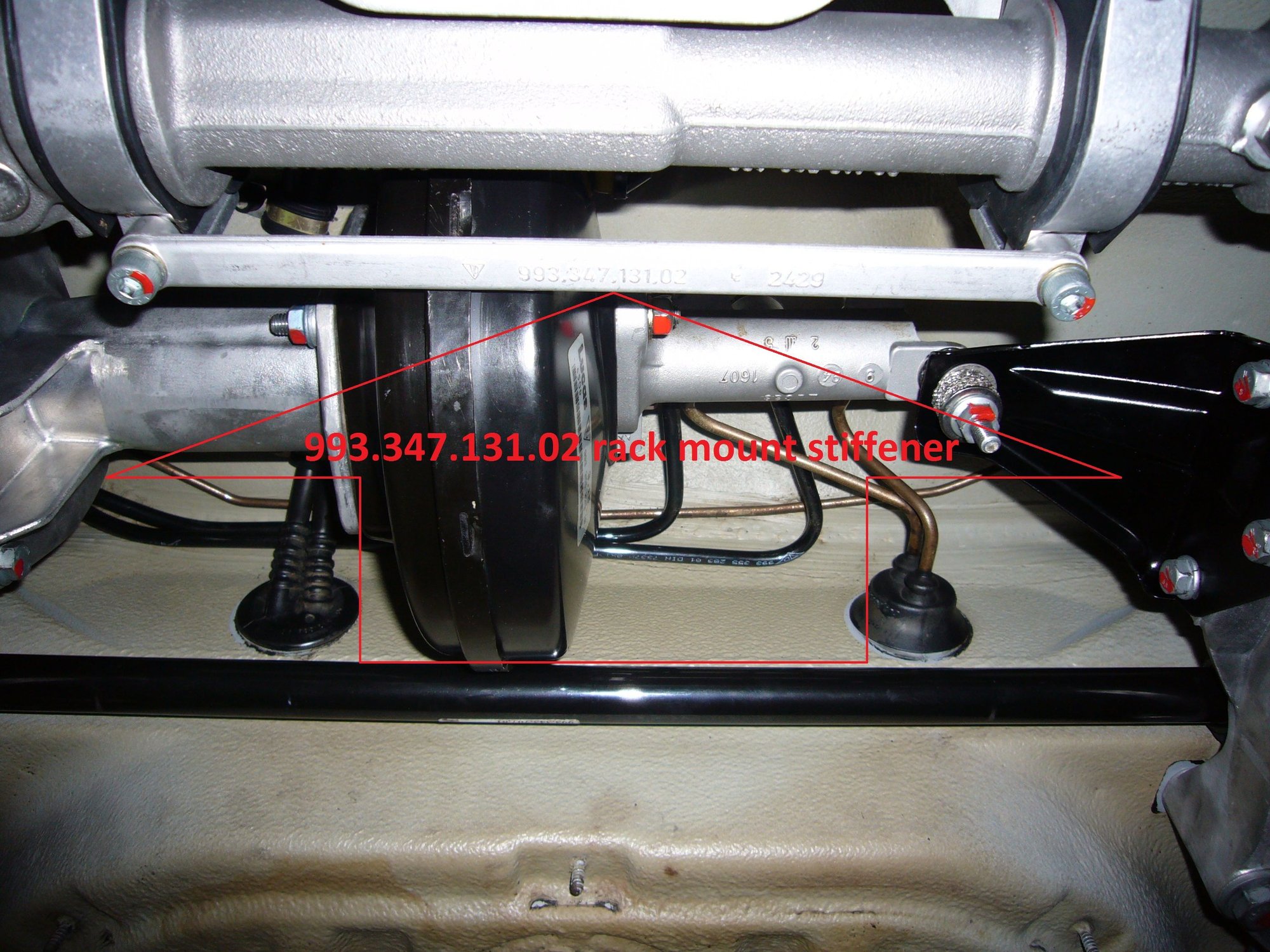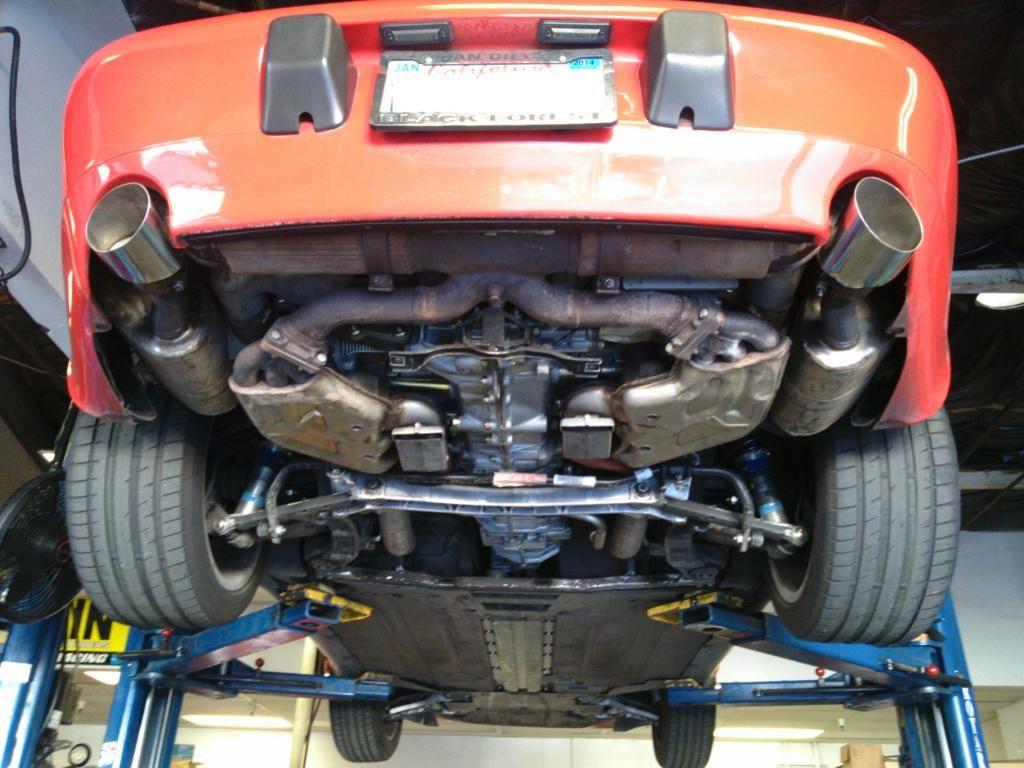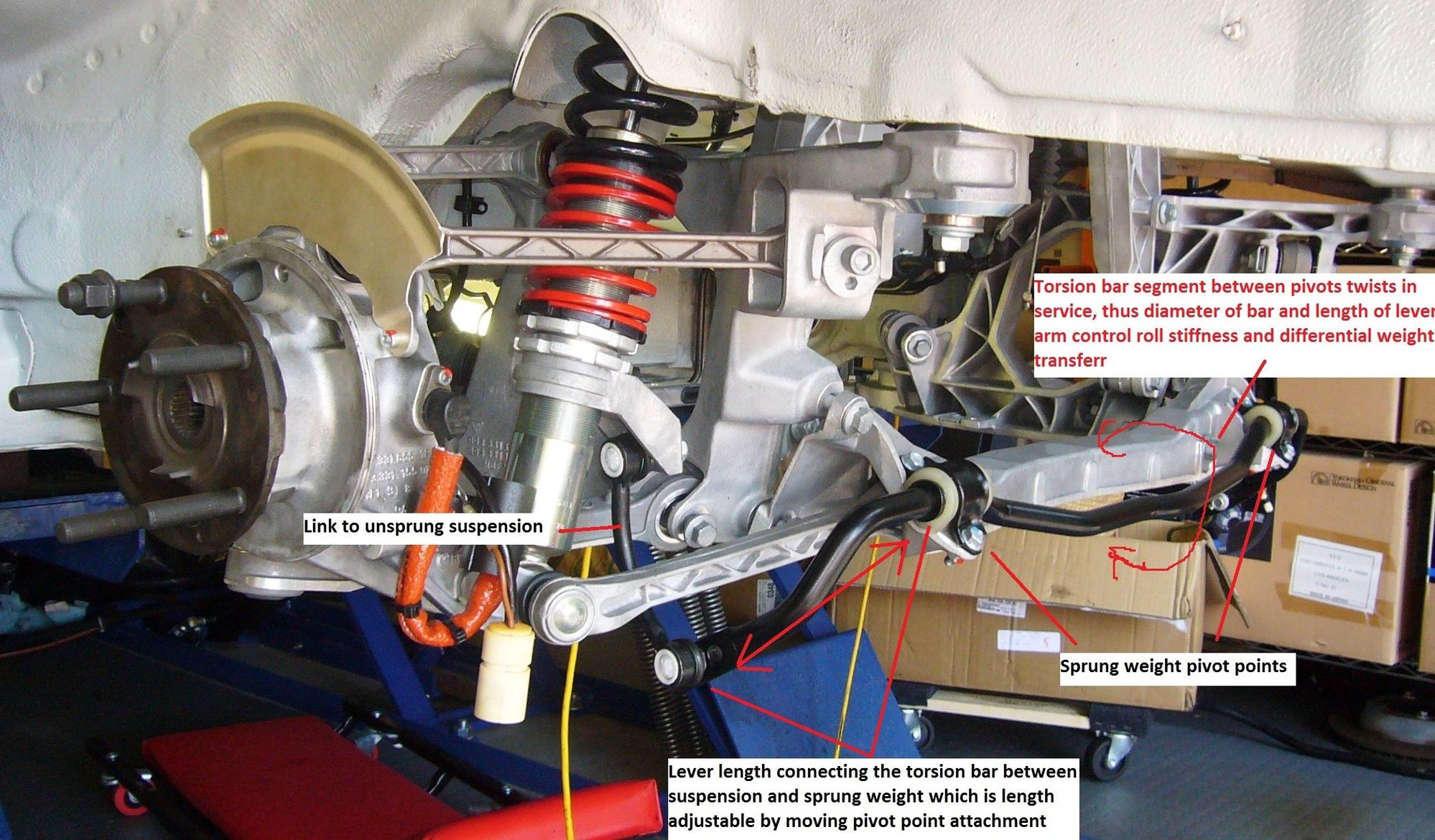Differences between 17” and 18” wheels
#77
Rennlist Member
I think the writer should have said y is the acceleration on the body in the diagram, but we used a in the equations.
These explain the differential in front rear slip angle causing oversteer or understeer, but not how a wider contact patch is more efficient in cornering stiffness.
These explain the differential in front rear slip angle causing oversteer or understeer, but not how a wider contact patch is more efficient in cornering stiffness.
#78
Wahoo! Now we're having fun!
Cupcar nailed it! Excellent explanation on the relationship between slip angle and cornering friction. I'm in nerd heaven here, gentlemen.
The Coloumbic model, of which the original equation is part and parcel, is a simplified approximation. While it can be quite versatile to describe many physical systems and situations, it ignores some variables encountered in real world application where, quite literally, the rubber meets the road.
The relationship between normal force and frictional force is not precisely linear; friction is not entirely independent of the contact area of surfaces. If we are forced to not expand our equation, the coefficient of friction would be represented by a curvey line instead of a straight one. Delicious calculus in the form of integrals would be needed to define such a relationship. It changes under different conditions. The Coulomb model is a valid one, mind you, it's just a bit hand-wavy in its assumptions.
Adhesion (compound stickiness), abrasion, and hysteresis are all important factors that can drive the coefficient of friction "placeholder variable" over unity.
As these asperites come into contact, they can mesh together tightly (keying or interlocking to each other) dissipating energy which will maximize frictional force. After all, tarmac and concrete are are not smooth as glass: there are many small little textural details in evidence for tires to smoosh in and around.
Bringing the tire temperature to the correct operating range is also a factor, which can improve adhesion even more by increasing the all important smooshing property. Yes, this is a technical term!
Finally, downforce from aerodynamic body mods can also increase the normal force acting on a tire patch, increasing friction.
Phew! That was fun! Thank you, gurus and physics laypersons alike!
Cupcar nailed it! Excellent explanation on the relationship between slip angle and cornering friction. I'm in nerd heaven here, gentlemen.
The Coloumbic model, of which the original equation is part and parcel, is a simplified approximation. While it can be quite versatile to describe many physical systems and situations, it ignores some variables encountered in real world application where, quite literally, the rubber meets the road.
The relationship between normal force and frictional force is not precisely linear; friction is not entirely independent of the contact area of surfaces. If we are forced to not expand our equation, the coefficient of friction would be represented by a curvey line instead of a straight one. Delicious calculus in the form of integrals would be needed to define such a relationship. It changes under different conditions. The Coulomb model is a valid one, mind you, it's just a bit hand-wavy in its assumptions.
Adhesion (compound stickiness), abrasion, and hysteresis are all important factors that can drive the coefficient of friction "placeholder variable" over unity.
As these asperites come into contact, they can mesh together tightly (keying or interlocking to each other) dissipating energy which will maximize frictional force. After all, tarmac and concrete are are not smooth as glass: there are many small little textural details in evidence for tires to smoosh in and around.
Bringing the tire temperature to the correct operating range is also a factor, which can improve adhesion even more by increasing the all important smooshing property. Yes, this is a technical term!
Finally, downforce from aerodynamic body mods can also increase the normal force acting on a tire patch, increasing friction.
Phew! That was fun! Thank you, gurus and physics laypersons alike!
Last edited by callipygian 911; 09-14-2014 at 01:45 PM.
#79
I think the writer should have said y is the acceleration on the body in the diagram, but we used a in the equations.
These explain the differential in front rear slip angle causing oversteer or understeer, but not how a wider contact patch is more efficient in cornering stiffness.
These explain the differential in front rear slip angle causing oversteer or understeer, but not how a wider contact patch is more efficient in cornering stiffness.
lower profile tires will run at lower slip angles and generate more grip than an other wise identical but higher profile tire, the ratio of front/rear slip angles explains over or under steer but that wasn't the point
#80
Rennlist Member
Bill, I knew what you were doing but wanted people not to look for the explanation of contact patch shape in that - and also that you were not the writer of the piece.
In Carmel at Rennsport I talked with a Michelin tire engineer there about this topic and was told that the tire companies are under a lot of pressure to make tires in lower profiles for larger rim diameters NOT for a performance increase, but for styling purposes only.
It was pointed out during the conversation that Porsche uses 18" rims for the 991 Cup cars and that 18" was the best diameter.
In Carmel at Rennsport I talked with a Michelin tire engineer there about this topic and was told that the tire companies are under a lot of pressure to make tires in lower profiles for larger rim diameters NOT for a performance increase, but for styling purposes only.
It was pointed out during the conversation that Porsche uses 18" rims for the 991 Cup cars and that 18" was the best diameter.
#81
Wow, what a thread! Has clearly expected my expectation, when I started it!
Would be interesting to learn more about the possible higher risk for getting a leaking steering rack, if going to 18”.
The no difference experiences in this thread would be interesting to go deeper into as well, maybe based on Porsche’s approved tires and wheels. Meaning, going to 18” from Michelin Pilot Sport PS2 on 17” CUP II (205/50, 255/40), might always lead to a comfort change compated to...
Personally I wouldn’t change my Cup II wheels only due to looks. I’m actually very satisfied with the Cup II wheels, so I will surely keep them in any case. But, to buy an additional high quality wheel set is very tempting…
Would be interesting to learn more about the possible higher risk for getting a leaking steering rack, if going to 18”.
The no difference experiences in this thread would be interesting to go deeper into as well, maybe based on Porsche’s approved tires and wheels. Meaning, going to 18” from Michelin Pilot Sport PS2 on 17” CUP II (205/50, 255/40), might always lead to a comfort change compated to...
Personally I wouldn’t change my Cup II wheels only due to looks. I’m actually very satisfied with the Cup II wheels, so I will surely keep them in any case. But, to buy an additional high quality wheel set is very tempting…

#82
Rennlist Member
"...The relationship between normal force and frictional force is not precisely linear; friction is not entirely independent of the contact area of surfaces. If we are forced to not expand our equation, the coefficient of friction would be represented by a curvey line instead of a straight one..."
Load sensitivity of the Coefficient of Friction of the tire is why stabilizer bar adjustment works.
"...Finally, downforce from aerodynamic body mods can also increase the normal force acting on a tire patch, increasing friction. Phew!..."
And essentially without increasing mass other than the added mass of wing. Why F1 goes nuts over weighing the drivers and cars after quali.
Load sensitivity of the Coefficient of Friction of the tire is why stabilizer bar adjustment works.
"...Finally, downforce from aerodynamic body mods can also increase the normal force acting on a tire patch, increasing friction. Phew!..."
And essentially without increasing mass other than the added mass of wing. Why F1 goes nuts over weighing the drivers and cars after quali.

#83
To put it in terms of slip angles, tightening or stiffening an adjustable sway bar will increase the slip angle of a wheel through a turn and loosening it will decrease the slip angle of a wheel through a turn. Adjusting the relative stiffness of front and rear sway bars alters the proportion of roll stiffness and distribution of total load transfer between front and rear axles. Increasing the proportion of roll stiffness at the rear axle relative to the front, for example, will change a car's balance to decrease understeer, which is what most of us 993 performance enthusiasts would prefer.
Great Scott! Adjustable bars sure sound like powerful tools to induce a car to oversteer or understeer in spite of differences in tire widths, even if they have diverging coefficients of friction and different grips due to tire load sensitivity.
This is so educational!
Last edited by callipygian 911; 09-14-2014 at 03:12 PM.
#84
Rennlist Member
Yes, the outside tire of an axle pair being loaded decreases grip more than the unloading of the inside tire gains grip, thus the grip of the axle pair decreases as the load differential increases. Load differential is controlled by stabilizer bar stiffness, the stiffer the greater the differential as the chassis rolls.
#85
Addict
Rennlist Member
Rennlist Member
Can someone actualy show this theoretical physicist what an adjustable sway bar looks like and how many adjustments (sic, how many, not how much) it actually has?
#87
Rennlist Member
#88
Addict
Rennlist Member
Rennlist Member
Now, look up the word "descreet" as it relates to the word "adjustment". You can also tell us the truth about your own setup suspension experience and your peresonal use of this suspension.
#89
The truth? You're incredibly rude and not very skilled at rhetoric. Argumentum ad hominem is a weak position. That's all you've got? BTW, it's spelled "discrete."
That is my car in the picture, you strange person. Plenty of Rennlisters out here know me and my car. I happen to be a chemist with an advanced degree from UCSD. I'm neither a car mechanic nor a theoretical physicist. I've had several years of coursework and laboratory experience in Newtonian physics, quantum mechanics (a school of study founded on discrete energetics, by the way), thermodynamics, and kinetics. How about you?
When it comes to suspension setup, I rely on the technical expertise of Steve Weiner and Steve Grosekemper. I never pretended to be a professional mechanic and I am the first to admit the limits of my knowledge. I am, however, not completely ignorant of these simple systems. I know full well how the adjustable RS sways function. I installed them on purpose so, yeah, I happen to be aware of how they look and function, sweetheart.
I have no idea why you expect me to explain myself to you, especially when you lack common courtesy.
Learn some manners.
That is my car in the picture, you strange person. Plenty of Rennlisters out here know me and my car. I happen to be a chemist with an advanced degree from UCSD. I'm neither a car mechanic nor a theoretical physicist. I've had several years of coursework and laboratory experience in Newtonian physics, quantum mechanics (a school of study founded on discrete energetics, by the way), thermodynamics, and kinetics. How about you?
When it comes to suspension setup, I rely on the technical expertise of Steve Weiner and Steve Grosekemper. I never pretended to be a professional mechanic and I am the first to admit the limits of my knowledge. I am, however, not completely ignorant of these simple systems. I know full well how the adjustable RS sways function. I installed them on purpose so, yeah, I happen to be aware of how they look and function, sweetheart.
I have no idea why you expect me to explain myself to you, especially when you lack common courtesy.
Learn some manners.
Last edited by callipygian 911; 09-15-2014 at 12:07 AM. Reason: Autocorrected discrete into discreet. Embarrassing.
#90
Addicted Specialist
Rennlist Member
Rennlist Member
All this does, really, is that given the same thickness of the bar, the different locating points just changes the leverage the bar has as the suspension moves in relationship to the chassis. Think of a longer prybar vs a shorter one: depending on the length of the "lever" there is greater or lesser force applied to keeping chassis roll in check. So adjustable bars at F and R allow one to fine tune the relative roll stiffness of each end of the car for the handling traits you desire.
FWIW and somewhat OT, when I replaced my stock boingers many many moons ago (Pss9), I opted for the stock sway bars from the RoW TT sport setup: cost of these porsche bars was less than whatever adjustables were out at the time, and installation/fit was seamless and as easy as stock sways, just get the right bushings. That rear RoW bar is killer, 21mm instead of the US' 20mm, and that 1mm makes a world of difference toward killing understeer! I mention this because I've heard that some industrious souls decided that they could gain even more resistance to roll by drilling in a hole or two on the bar's end ...again, changing its leverage, effectively "adding thickness," as it were, to the bar without, um, adding thickness.
I add this bit about the sways because this consideration of roll resistance is completely related to contact patch. Increase roll stiffness (as in "more bar") and you can eek out a bit more grip from a higher-profile tire than you could with a more compliant swaybar. As was said much earlier in this thread, the whole suspension "system" works together as a system, so simply going to 18s (or 19s, whatever) to drop sidwall height is but one scant factor in the entire equation. Gotta consider the whole bag and the resultant compromises before going this way or that.

Edward




